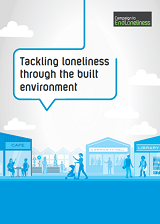Tackling loneliness through the built environment

Published by Campaign to End Loneliness to coincide with World Cities Day 2022, this report sets out why the built environment matters for loneliness, what features make a difference to our experience and how this can be achieved.
With new figures showing 3.8 million people in Britain are now chronically lonely, this report argues that the design of our neighbourhoods can play an important role in tackling loneliness and helping people connect.
The report found that the way we plan and design our built environment needs to encourage different kinds of interaction – we need bumping spaces like benches where we might see neighbours or acquaintances – so called ‘weak ties’.
Alongside this we also need places for the creation of ‘strong ties’ where we develop and maintain real friendships, for example at community groups and activities.
A ‘less lonely’ neighbourhood needs to have the right collection of buildings and friendly shared places which are liked by residents and are, therefore, comfortable to use and will foster encounters with others’.
The report also draws attention to a number of great examples, a couple featured by the Housing LIN. For example, the cohousing development in Cambridge, Marmalade Lane, and a selection of award-winning age-friendly designs inspired by HAPPI. See additional links below.
